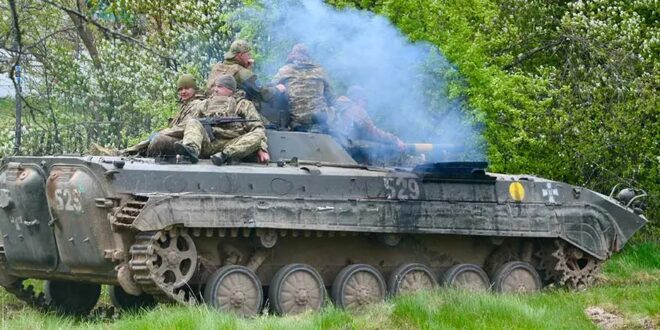Russian tactics are changing as lessons are learned from military failures in the war in Ukraine.
Executive Summary
The scale of Russian losses in 2022, combined with the Armed Forces of the Russian Federation confronting NATO systems they had not previously contended with, has caused a significant deviation in Russian operations from the country’s doctrine. This report seeks to outline how Russian forces have adapted their tactics in the Ukrainian conflict and the challenges this has created for the Ukrainian military that must be overcome. The report examines Russian military adaptation by combat function.
Russian infantry tactics have shifted from trying to deploy uniform Battalion Tactical Groups as combined arms units of action to a stratified division by function into line, assault, specialised and disposable troops. These are formed into task-organised groupings. Line infantry are largely used for ground holding and defensive operations. Disposable infantry are used for continuous skirmishing to either identify Ukrainian firing positions, which are then targeted by specialised infantry, or to find weak points in Ukrainian defences to be prioritised for assault. Casualties are very unevenly distributed across these functions. The foremost weakness across Russian infantry units is low morale, which leads to poor unit cohesion and inter-unit cooperation.
Russian engineering has proven to be one of the stronger branches of the Russian military. Russian engineers have been constructing complex obstacles and field fortifications across the front. This includes concrete reinforced trenches and command bunkers, wire-entanglements, hedgehogs, anti-tank ditches, and complex minefields. Russian mine laying is extensive and mixes anti-tank and victim-initiated anti-personnel mines, the latter frequently being laid with multiple initiation mechanisms to complicate breaching. These defences pose a major tactical challenge to Ukrainian offensive operations.
Russian armour is rarely used for attempts at breakthrough. Instead, armour is largely employed in a fire support function to deliver accurate fire against Ukrainian positions. Russia has started to employ thermal camouflage on its vehicles and, using a range of other modifications and tactics, techniques and procedures (TTPs), has significantly reduced the detectability of tanks at stand-off ranges. Furthermore, these measures have reduced the probability of kill of a variety of anti-tank guided missiles (ATGMs) at ranges beyond 1,400 m.
Russian artillery has begun to significantly refine the Reconnaissance Strike Complex following the destruction of its ammunition stockpiles and command and control infrastructure by guided multiple-launch rocket systems (GMLRS) in July 2022. This has resulted in much closer integration of multiple UAVs directly supporting commanders authorised to apply fires. Russian artillery has also improved its ability to fire from multiple positions and to fire and move, reducing susceptibility to counterbattery fire. The key system enabling this coordination appears to be the Strelets system. There has been a shift in reliance upon 152-mm howitzers to a much greater emphasis on 120-mm mortars in Russian fires; this reflects munitions and barrel availability. Responsive Russian fires represent the greatest challenge to Ukrainian offensive operations. Russian artillery is also increasingly relying on loitering munitions for counterbattery fires.
Russian electronic warfare (EW) remains potent, with an approximate distribution of at least one major system covering each 10 km of front. These systems are heavily weighted towards the defeat of UAVs and tend not to try and deconflict their effects. Ukrainian UAV losses remain at approximately 10,000 per month. Russian EW is also apparently achieving real time interception and decryption of Ukrainian Motorola 256-bit encrypted tactical communications systems, which are widely employed by the Armed Forces of Ukraine.
Russian air defences have also seen a significant increase in their effectiveness now that they are set up around known, and fairly static, locations and are properly connected. Although Russia has persistently struggled to respond to emerging threats, over time it has adapted. Russian air defences are now assessed by the Ukrainian military to be intercepting a proportion of GMLRS strikes as Russian point defences are directly connected to superior radar.
Russian aviation remains constrained to delivering stand-off effects, ranging from responsive lofted S-8 salvos against Ukrainian forming-up points, to FAB-500 glide bombs delivered from medium altitude to ranges up to 70 km. The Ukrainian military notes that Russia has a large stockpile of FAB-500s and is systematically upgrading them with glide kits. Although they only have limited accuracy, the size of these munitions poses a serious threat. The Russian Aerospace Forces remain a ‘force in being’ and a major threat to advancing Ukrainian forces, although they currently lack the capabilities to penetrate Ukrainian air defences.
Following the destruction of Russian command and control infrastructure in July 2022, the Russian military withdrew major headquarters out of range of GMLRS and placed them in hardened structures. They also wired them into the Ukrainian civil telecommunications network and used field cables to branch from this to brigade headquarters further forward. Assigned assets tend to connect to these headquarters via microlink, significantly reducing their signature. At the same time, from the battalion down, Russian forces largely rely on unencrypted analogue military radios, reflecting a shortage of trained signallers at the tactical level.
An overview of Russian adaptation reveals a force that is able to improve and evolve its employment of key systems. There is evidence of a centralised process for identifying shortcomings in employment and the development of mitigations. Nevertheless, much of this adaptation is reactive and is aimed at making up for serious deficiencies in Russian units. The result is a structure that becomes better over time at managing the problems it immediately faces, but also one that struggles to anticipate new threats. The conclusion therefore is that the Russian Armed Forces pose a significant challenge for the Ukrainian military on the defence. Nevertheless, if Ukraine can disrupt Russian defences and impose a dynamic situation on them, Russian units are likely to rapidly lose their coordination. Changes in the air combat environment, for example, have led rapidly to incidents of Russian fratricide.
 Eurasia Press & News
Eurasia Press & News



